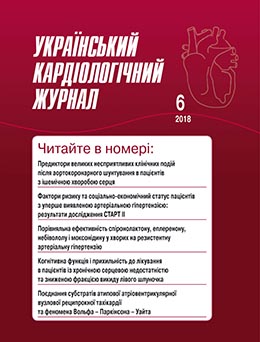The acute coronary syndrome without ST segment elevation and concomitant essential hypertension clinical presentation features in men and women with Helicobacter pylori infection
Main Article Content
Abstract
The aim – to investigate the acute coronary syndrome without ST segment elevation and concomitant essential hypertension clinical presentation in men and women with Helicobacter pylori infection.
Material and methods. 197 acute coronary syndrome without ST segment elevation patients (age 45–83 years) with essential arterial hypertension and dyspesia were investigated according to the current clinical protocols with total antibodies to Helicobacter pylori rate detection. The patients were divided by the groups of men and women, infected and uninfected with Helicobacter pylori. The clinical presentation of acute coronary syndromes was evaluated using the 13-item Acute coronary syndrome symptoms checklist and the dyspepsia symptoms were estimated by the Likert scale.
Results. In case of Helicobacter pylori infection compared to uninfected patients a significantly higher severity of chest pain, shoulder pain and upper back pain had been revealed, while among women the chest discomfort, sweating and palpitations significantly prevailed. The intensity of dyspeptic symptoms, especially heartburn and nausea, was significantly higher among women infected with Helicobacter pylori. A significant progression of heart failure with higher prevalence of edema and liver enlargement were revealed in men infected with Helicobacter pylori versus uninfected and in men versus women regardless of Helicobacter pylori infection factor.
Conclusions. The obtained link between the total antibodies to Helicobacter pylori titer and the patients’ age, male gender, myocardial infarction history, the prevalence of edema and liver enlargement might indicate a significant clinical course deterioration and heart failure progression in elderly male patients with acute coronary syndromes without ST segment elevation and essential hypertension in case of Helicobacter pylori infection.
Article Details
Keywords:
References
Arterialna hipertenziia. Unifikovanyi klinichnyi protokol nadannia pervynnoi, ekstrenoi ta vtorynnoi (spetsializovanoi) medychnoi dopomohy. Kyiv, 2012.72p. (in Ukr.).
Nakaz Ministerstva oxorony zdorov'ya 13.06.2005 №271. Pro zatverdzhennya protokoliv nadannya medychnoyi dopomohy za special"nistyu "Hastroenterolohiya". K: 2005.27p. (in Ukr.).
Nakaz Ministerstva okhorony zdorovia 03.07.2006 №436. Pro zatverdzhennia protokoliv nadannia medychnoi dopomohy za spetsialnistiu "Kardiolohiia".K: 2005.27p. (in Ukr.).
Nakaz Ministerstva okhorony zdorovia 03.09.2014 №613. Pro zatverdzhennia ta vprovadzhennia medyko-tekhnolohichnykh dokumentiv zi standartyzatsii medychnoi dopomohy pry peptychnii vyraztsi shlunka ta dvanadtsiatypaloi kyshky. K: 2014.26p. (in Ukr.).
Nakaz Ministerstva okhorony zdorovia 06.11.2014 №826. Pro zatverdzhennia ta vprovadzhennia medyko-tekhnolohichnykh dokumentiv zi standartyzatsii medychnoi dopomohy pry khronichnykh neinfektsiinykh hepatytakh. K: 2014.25p. (in Ukr.).
Osodlo HV. Kuts TV, Kalashnikov MA.Funktsionalna dyspepsiia v klinichnii praktytsi: nevyrisheni pytannia ta perspektyvy. Ukrainskyi terapevtychnyi zhurnal [University Therapeutic Journal]. 2009;1:25–29. (in Ukr.).
Pavlov ON. Nositelstvo Helicobacter pylori kak skrytyj sistemnyj faktor riska. Medicinskij almanah. 2011;4:125–130. (in Russ.).
Unifikovanyi klinichnyi protokol nadannia pervynnoi, ekstrenoi ta vtorynnoi (spetsializovanoi), tretynnoi (vysokospetsializovanoi) medychnoi dopomohy ta medychnoi reabilitatsii. Hostryi koronarnyi syndrom bez elevatsii sehmenta ST. Kyiv, 2016.79p. (in Ukr.).
ACS symptom checklist [online]. Assess: https://thinksymptoms.nursing.uic.edu/study-tools activation and aggregation studied with flow cytometry use and light transmission aggregometry). J Am Coll Cardiol 2014;63:1289–1296 https://doi.org/10.1159/000217194
Budzyński J, Koziński M, Kłopocka M, Kubica JM, Kubica J. Clinical significance of Helicobacter pylori infection in patients with acute coronary syndromes: an overview of current evidence. Clin Res Cardiol. 2014;103(11): 855–86. https://doi.org/10.1007/s00392-014-0720-4
Canto JG, Canto EA, Goldberg RJ. Time to standardize and broaden the criteria of acute coronary syndrome symptom presentations in women. Can J Cardiol 2014;30:721-8. https://doi.org/10.1016/j.cjca.2013.10.015
DeVon HA, Rosenfeld A, Steffen AD, Daya M. Sensitivity, specificity, and sex differences in symptoms reported on the 13-item acute coronary syndrome checklist. J Am Heart Assoc. 2014 Apr; 3(2): e000586. https://doi.org/10.1161/jaha.113.000586
Malfertheiner P, Megraud F, O'Morain CA, Gisbert JP, Kuipers EJ, Axon AT, Bazzoli F, Gasbarrini A, Atherton J, Graham DY, Hunt R, Moayyedi P, Rokkas T, Rugge M, Selgrad M, Suerbaum S, Sugano K, El-Omar EM; European Helicobacter and Microbiota Study Group and Consensus panel. Management of Helicobacter pylori infection-the Maastricht V/Florence Consensus Report. Gut. 2017 Jan;66(1):6-30. doi: 10.1136/gutjnl-2016-312288
Mansour H, Reda A, Mena M, Ghaleb R, Elkersh A. Pattern of risk factors and management strategies in patients with acute coronary syndrome, in different age groups and sex categories. Atherosclerosis Supp. 2017;25:e1–e11. https://doi.org/10.1016/j.atherosclerosissup.2017.03.014
Peter Libby, Ira Tabas, Gabrielle Fredman, and Edward Fisher. Inflammation and its resolution as determinants of acute coronary syndromes. Circ Res. 2014 June 6; 114(12): 1867–1879. https://doi.org/10.1161/circresaha.114.302699

